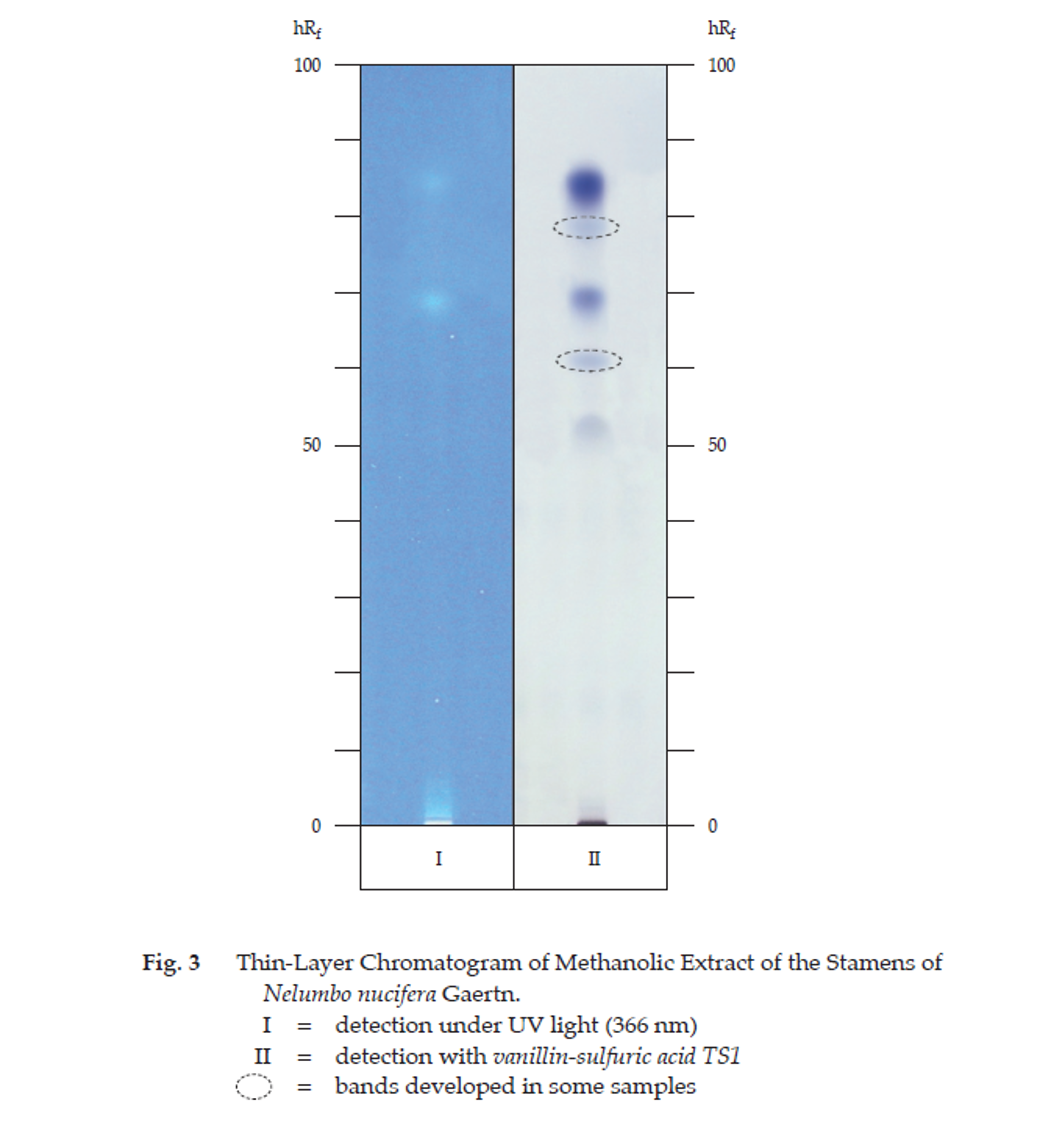ตำรามาตรฐานยาสมุนไพรไทย
Thai Herbal Pharmacopoeia
สำนักยาและวัตถุเสพติด กรมวิทยาศาสตร์การแพทย์ กระทรวงสาธารณสุข
Bureau of Drug and Narcotic, Department of Medical Sciences, Ministry of Public Health(Tinospora crispa (L.) Hook.f. & Thomson)
(Nelumbo nucifera Gaertn.)
(Centella asiatica (L.) Urb.)
(Centella Dry Extract)
(Centella Cream)
(Mesua ferrea L.)
(Piper sarmentosum Roxb.)
(Piper sarmentosum Roxb.)
(Pterocarpus santalinus L. f.)
(Santalum album L.)
(Senna tora (L.) Roxb.)
(Senna alata (L.) Roxb.)
(Senna Alata Tea)
(Piper retrofractum Vahl)
(Myristica fragrans Houtt)
(Andrographis paniculata (Burm. f.) Nees)
(Andrographis Capsules)
(Allium ascalonicum L.)
(Ocimum tenuiflorum L.)
(Curcuma longa L.)
(Turmeric Capsules)
(Turmeric Dry Extract)
(Turmeric Dry Extract Capsules)
(Arcangelisia flava (L.) Merr.)
(Curcuma sp.)
Harrisonia perforata (Blanco) Merr.
(Aristolochia pierrei Lecomte)
(Zingiber officinale Roscoe)
(Ginger Capsules)
(Ginger Tea)
(Cassia fistula L.)
(Nardostachys jatamansi (D. Don) DC.)
(Angelica sinensis (Oliv.) Diels)
Artemisia annua L.
(Ligusticum sinense Oliv. cv. Chuanxiong)
(Neopicrorhiza scrophulariiflora Pennell)
(Atractylodes lancea (Thunb.) DC.)
(Aucklandia lappa Decne)
(Terminalia chebula Retz.)
(Angelica dahurica (Hoffm.) Benth. & Hook. f. ex Franch. & Sav. var. dahurica)
(Kaempferia parviflora Wall. ex Baker)
(Hibiscus sabdariffa L.)
(Roselle Tea)
(Allium sativum L.)
(Zingiber zerumbet (L.) Sm.)
(Wurfbainia testacea (Ridl.) Škorničk.& A. D. Poulsen)
(Cannabis sativa L.)
(Myristica fragrans Houtt)
(Dracaena cochinchinensis (Lour.) S. C. Chen)
(Ficus racemosa L.)
(Hyptis suaveolens (L.) Poit.)
Clerodendrum indicum (L.) Kuntze
(Phyllanthus emblica L.)
(Citrus hystrix DC.)
(Citrus hystrix DC.)
(Areca catechu L.)
(Momordica charantia L.)
Moringa oleifera Lam.
(Aegle marmelos (L.) Corrêa)
(Solanum trilobatum L.)
(Morus alba L.)
Gynostemma pentaphyllum(Thunb.)
Makino
(Clinacanthus nutans (Burm. f.) Lindau)
(Cissus quadrangularis L.)
(Mimusops elengi L.)
(Zingiber montanum (J. König) Link. ex A. Dietr.)
(Piper betle L.)
(Capsicum annuum L.)
(Capsicum Oleoresin)
(Capsicum Gel)
(Piper nigrum L.)
(Piper nigrum L.)
(Eurycoma longifolia Jack)
(Thunbergia laurifolia Lindl.)
(Piper wallichii (Miq.) Hand.-Mazz.)
Senna garrettiana (Craib) H. S. Irwin & Barneby
(Terminalia bellirica (Gaertn.) Roxb.)
(Terminalia chebula Retz.)
(Caesalpinia bonduc (L.) H. Roxb.)
(Tarlmounia elliptica (DC.) H. Rob., S. C. Keeley, Skvaria & R. Chan)
(Hog Creeper Vine Dry Extract Capsiles)
(Hog Creeper Vine Dry Extract)
(Brachypterum scandens (Roxb.) Miq.)
(Lepidium sativum L.)
(Nigella sativa L.)
(Cuminum cyminum L.)
(Foeniculum vulgare Mill.)
(Plantago ovata Forssk.)
(Pimpinella anisum L.)
(Carum carvi L.)
(Anethum graveolens L.)
(Trachyspermum ammi (L.) Sprague)
Albizia procera (Roxb.) Benth.
(Acorus calamus L.)
(Tiliacora triandra (Colebr.) Diels)
Cyanthillium cinereum (L.) H. Rob.
(Orthosiphon aristatus (Blume) Miq.)
Murdannia loriformis (Hassk.) R. S. Rao & Kammathy
(Capparis micracantha DC.)
(Chrysopogon zizanioides (L.) Roberty)
(Cyperus rotundus L.)
(Cannabis sativa L.)
(Syzygium aromaticum (L.) Merr. & L. M. Perry)
(Boesenbergia rotunda (L.) Mansf.)
(Acanthus ebracteatus Vahl)
(Acanthus ilicifolius L.)
(Kaempferia galanga L.)
(Curcuma comosa Roxb.)
Betula alnoides Buch.-Ham. ex D. Don
Cannabis sativa L.
Carthamus tinctorius L
Mitragyna speciosa (Korth.) Havil
Mallotus repandus (Rottler) Müll. Arg
Azadirachta indica A. Juss. var. siamensis Valeton
Azadirachta indica A. Juss. var. siamensis Valeton
Punica granatum L.
Rhinacanthus nasutus (L.) Kurz
Baliospermum solanifolium (Burm.) Suresh
Curcuma aeruginosa Roxb
Boesenbergia kingii Mood & L. M. Prince
Senegalia rugata (Lam.) Britton & Rose
Acacia concinna (Willd.) DC.
Senegalia rugata (Lam.) Britton & Rose
Acacia concinna (Willd.) DC.
Senna alexandriana Mill. var. alexandriana
Cassia acutifolia Delile, Cassia angustifolia Vahl
Butea superba Roxb. ex Willd.
[Plaso superba (Roxb. ex Willd.) Kuntze, Rudolphia superba (Roxb. ex Willd.) Poir.
Pueraria candollei Graham
ex Benth. var. mirifica (Airy Shaw & Suvat.) Niyomdham
Streblus asper Lour.
Suregada multiflora (A. Juss.) Baill. (Gelonium
multiflorum A. Juss.
Plumbago zeylanica L.
Plumbago indica L.
Biancaea sappan (L.) Tod.
Ziziphus attopensis Pierre
Streblus asper Lour.
Justicia gendarussa Burm. f.
Enhalus acoroides (L. f.) Royle
Bridelia ovata Decne.
Tamarindus indica L.
Citrus × aurantiifolia (Christm.) Swingle
Garcinia mangostana L.
Blumea balsamifera (L.) DC
Persicaria odorata (Lour.) Soják
Zingiber montanum (J. König) Link ex A. Dietr.
Mammea siamensis (Miq.) T. Anderson
Citrus maxima (Burm.) Merr.
Citrus × aurantium L. ‘Som Sa’
Punica granatum L.
Rhinacanthus nasutus (L.) Kurz
Sacred Lotus Stamen is the dried stamen of Nelumbo nucifera Gaertn. (Nelumbium speciosum Willd.) (Family Nelumbonaceae), Herbarium Specimen Number: DMSC 5156, Crude Drug Number: DMSc 0891, 0892.
Constituents Sacred Lotus Stamen contains flavonoids and carotenoids as its major components. It also contains arbutin, β-sitosterol glucopyranoside, etc.
Description of the plant (Figs. 1a, 1b) Perennial aquatic herb with milky latex and stout creeping rhizomes. Leaves simple, alternate, arising above the water surface, circular, 10 to 100 cm in diameter, margin entire or slightly undulate, papery, greyish green below, green on the upper, peltate, veins radiate from its centre in all directions, become forked near the margin; petiole terete, stout, up to 1 m or more long, about 1 cm in diameter, smooth or prickly. Flower solitary, large and showy, on thick peduncle rising several centimetres above the leaves; flower bud ovate, acute, 5 to 8 cm long, flower hemispheric at anthesis, 8 to 25 cm in diameter; perianth with 4 or 5 outermos t sepals, elliptic to ovate, 1.5 to 5 cm long, 0.8 to 3.5 cm wide, free, green or pinkish green, to white or pink with age, petal-like, incurved; petals 5 to numerous, elliptic, 4 to 15 cm long, 2 to 8 cm wide, obtuse, incurved, white to dark pink or reddish; stamens numerous, 2.2 to 4.5 cm long, anther linear, 1.5 to 2 cm long, up to 2 mm wide, golden yellow, with white clavate connective appendage up to 7 mm long at the apex, incurved; ovary apocarpous, 12 to 30 free carpels; receptacle expanded to cone-shape, flat upper surface, 3 to 5 cm long, about 2.5 cm wide with individual carpels sunken into it; style short. Fruit indehiscent nutlets, embedded in an accrescent spongy conical receptacle, 9 to 13 cm long, 4 to 7 cm wide; nutlet ovoid, 1.5 to 2 cm long; pericarp thick, hard, brownish or greyish black when dry, endocarp thin, whitish pulp. Seed 1.
Description Odour, slightly aromatic; taste, astringent.
Macroscopical (Fig. 1a) Sacred Lotus Stamen consists of anther, anther connective appendage and filament. Anther linear, twisted, longitudinally split, 1.2 to 1.5 cm long, about 1 mm in diameter, pale yellow to brownish yellow. Filament slender, slightly-curved, 1.5 to 1.8 cm long, pale yellow to brownish.
Microscopical (Figs. 2a, 2b) Transverse section of the filament shows an epidermal layer with papillae, secretory substances in a parenchyma layer adjacent to the epidermal layer, loose parenchyma cells, some of which contain secretory subs tances, air spaces, and a vascular bundle at the centre.
Transverse section of the anther reveals an epidermal layer with papillae, a fibrous layer, pollen grains in 4 pollen sacs. The contact region between filament and the 4 pollen sacs shows an epidermal layer, parenchyma cells, some of which contain secretory substances and a vascular bundle at the centre.
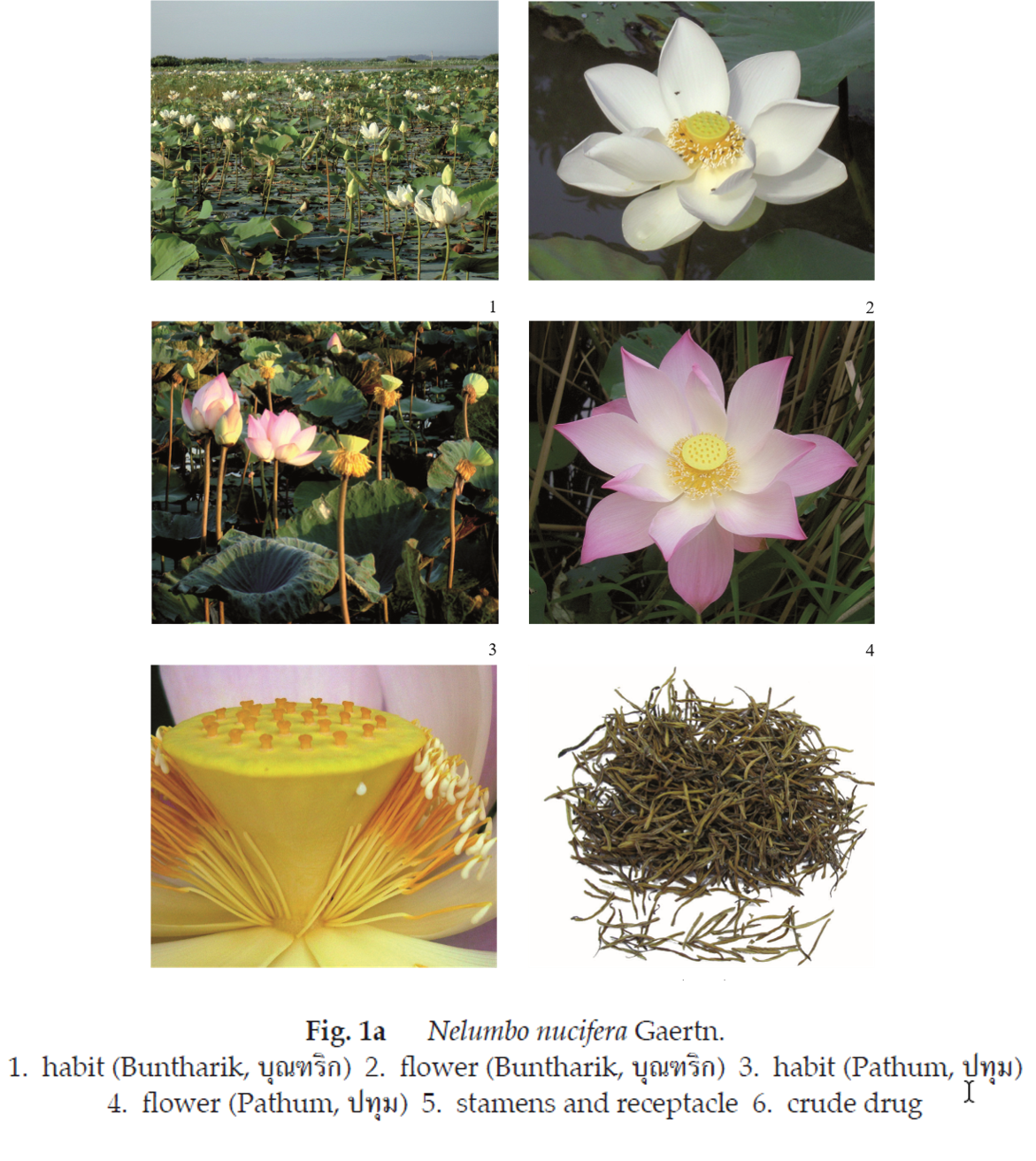
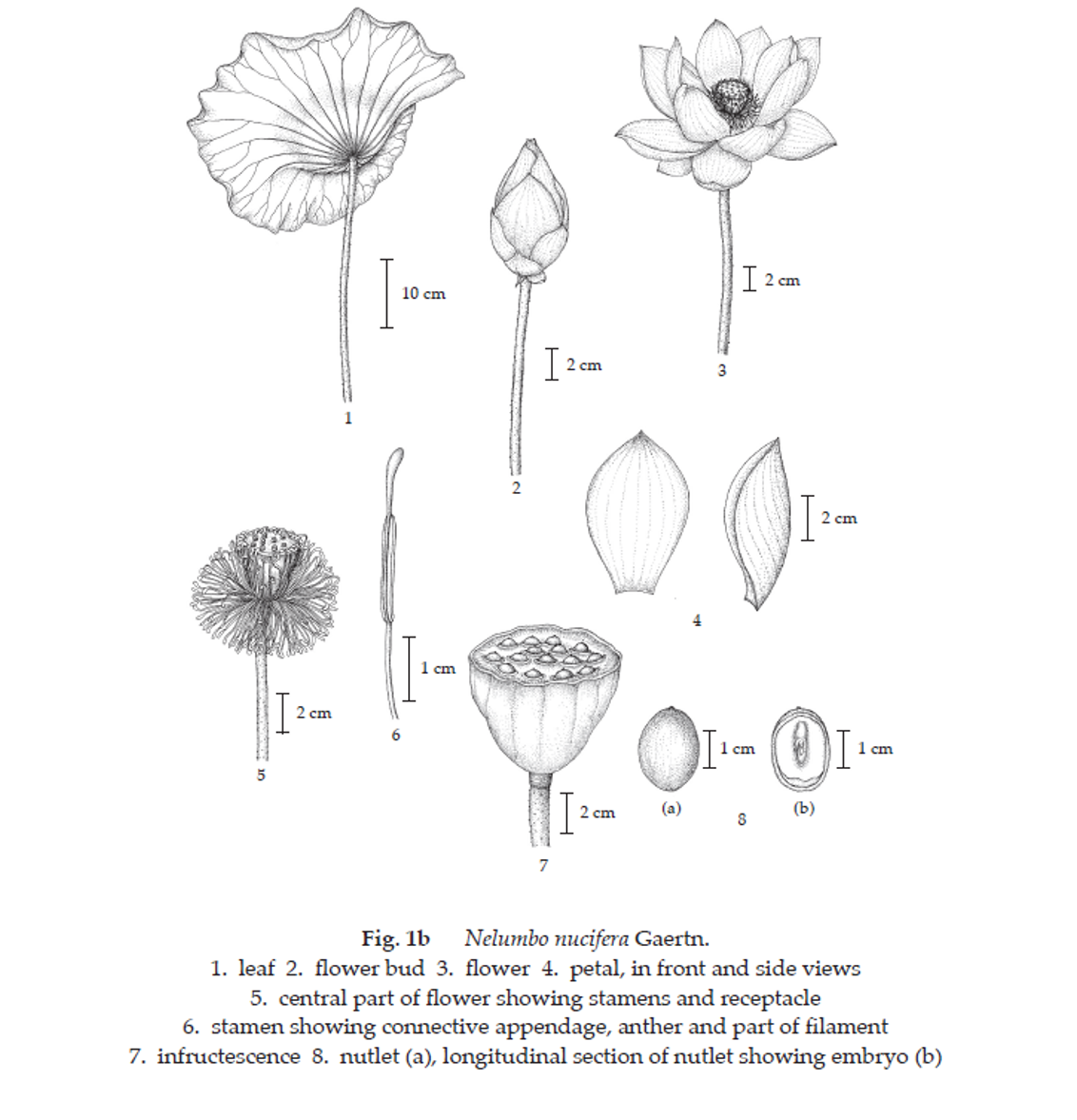
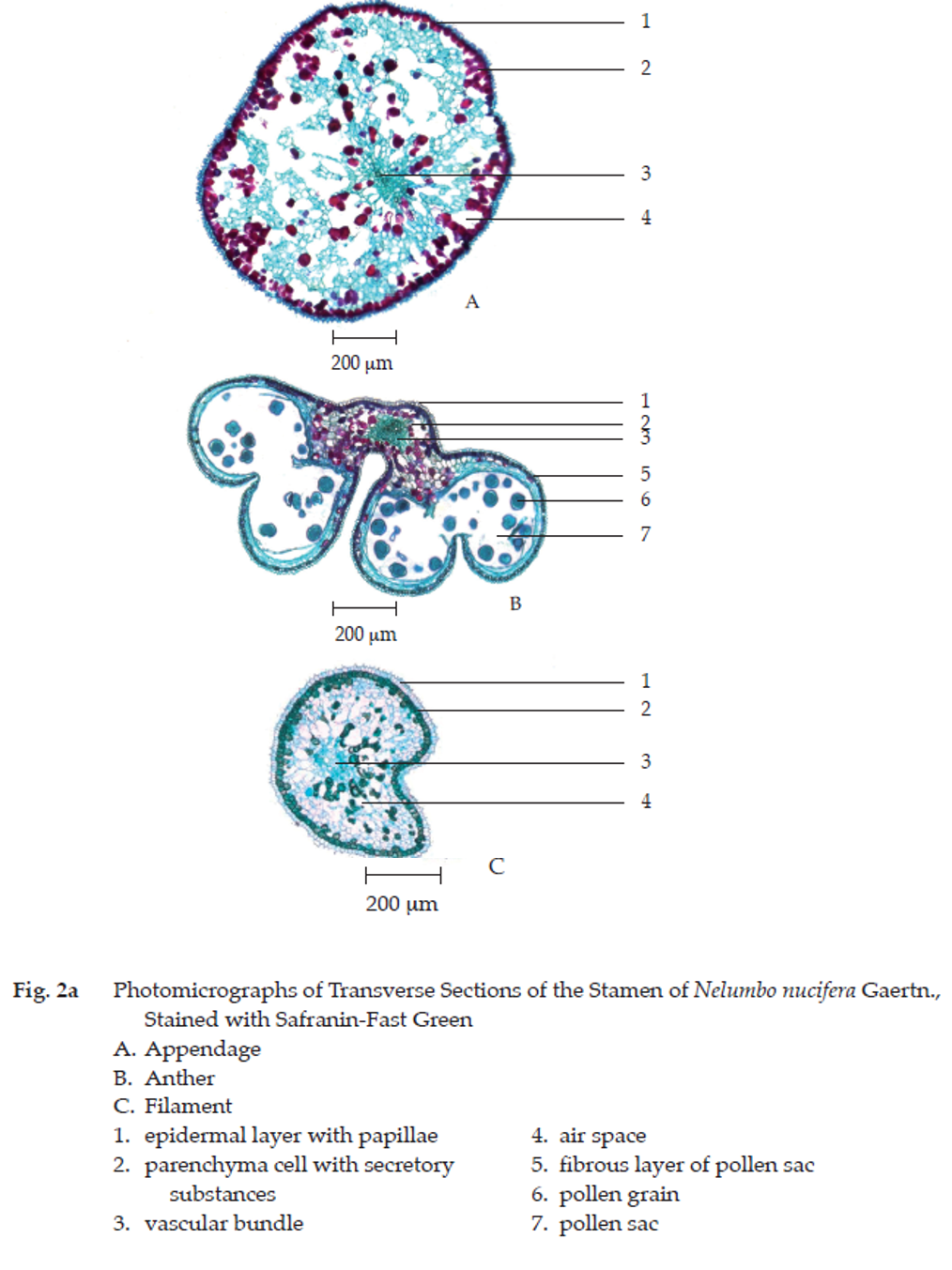
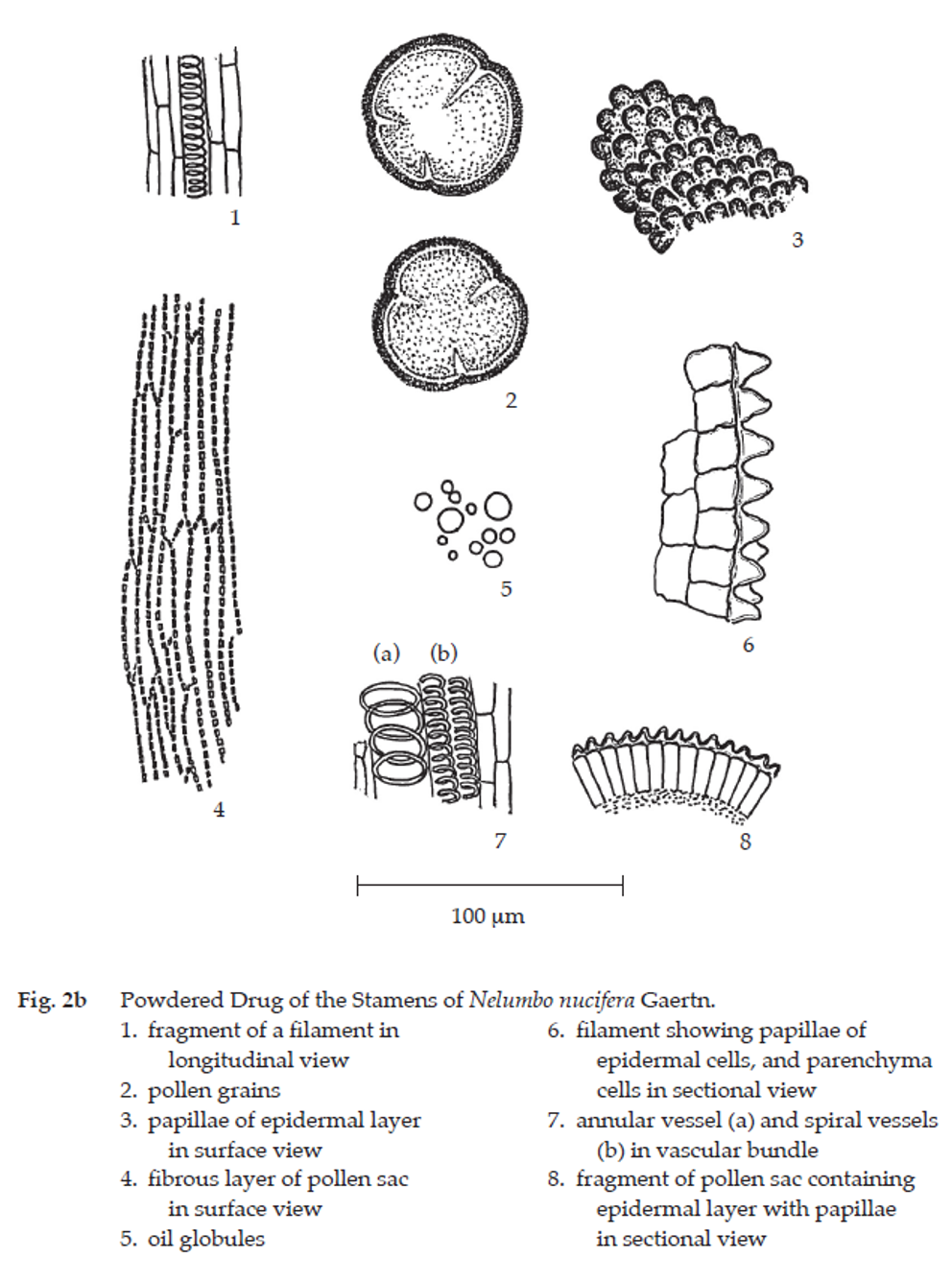
Transverse section through appendage of the stamen illustrates an epidermal layer with papillae, secretory substances in a parenchyma layer adjacent to the epidermal layer, loose parenchyma cells, some of which contain secretory substances, air spaces, and a vascular bundle at the centre.
Sacred Lotus Stamen in powder possesses the diagnostic microscopical characters of the unground drug.
Additional information
1. Sacred lotus cultivated in Thailand is classified into four types based on the form of the flower bud and the colour of the flower: Pathum (ปทุม), Buntharik (บุณฑริก), Sattabongkot (สัตตบงกช), and Sattabut (สัตตบุษย์). Only stamens of the first two types are used in Thai traditional medicine.
2. It is commonly used with other herbal drugs in Thai traditional herbal preparations.
Packaging and storage Sacred Lotus Stamen shall be kept in well-closed containers, protected from light, and stored in a dry place.
Identification
A. Sonicate 2.5 g of the sample, in fine powder, with 10 mL of methanol for 45 minutes, centrifuge and use a clear supernatant (solution 1). To 1 mL of solution 1, add 2 or 3 pieces of magnesium ribbon, shake well and mix with 4 drops of hydrochloric acid: a pink colour develops.
B. To 1 mL of solution 1, add 10 mg of zinc powder and 4 drops of hydrochloric acid and shake well: a reddish orange colour develops.
C. To 1 mL of solution 1, add 4 drops of sulfuric acid and shake well: a brown colour develops.
D. Carry out the test as described in the “Thin-Layer Chromatography” (Appendix 3.1), using silica gel GF254 as the coating substance and a mixture of 60 volumes of ethyl acetate and 40 volumes of toluene as the mobile phase. Apply to the plate as a band of 5 mm, 15 µL of the test solution prepared by sonicating 100 mg of the sample, in fine powder, with 10 mL of methanol for 15 minutes, filtering, and evaporating the filtrate to dryness. Dissolve the residue in 1.5 mL of methanol. After removal of the plate, allow it to dry in air and examine the plate under ultraviolet light (366 nm); two blue bands are observed. Spray the plate with vanillin-sulfuric acid TS1 and heat at 120° for 5 minutes; several violet bands appear (Table 1); see also Fig. 3.
Table 1 hRf Values of Components in Methanolic Extract of the Stamens of Nelumbo nucifera Gaertn.
| Band | hRf Value | Detection | |
| UV 366 | Vanillin-Sulfuric Acid TS1 | ||
| 1 | 52-53 | - | pale violet |
| 2 | 61-62 | - | pale violet |
| 3 | 69-70 | blue | violet |
| 4 | 77-79 | - | pale violet |
| 5 | 84-85 | light blue | violet |
Loss on drying Not more than 12.0 per cent w/w after drying at 105° for 3 hours (Appendix 4.15).
Foreign matter Not more than 2.0 per cent w/w (Appendix 7.2).
Acid-insoluble ash Not more than 1.0 per cent w/w (Appendix 7.6).
Total ash Not more than 6.0 per cent w/w (Appendix 7.7).
Water-soluble extractive Not less than 10.5 per cent w/w (Appendix 7.12).
